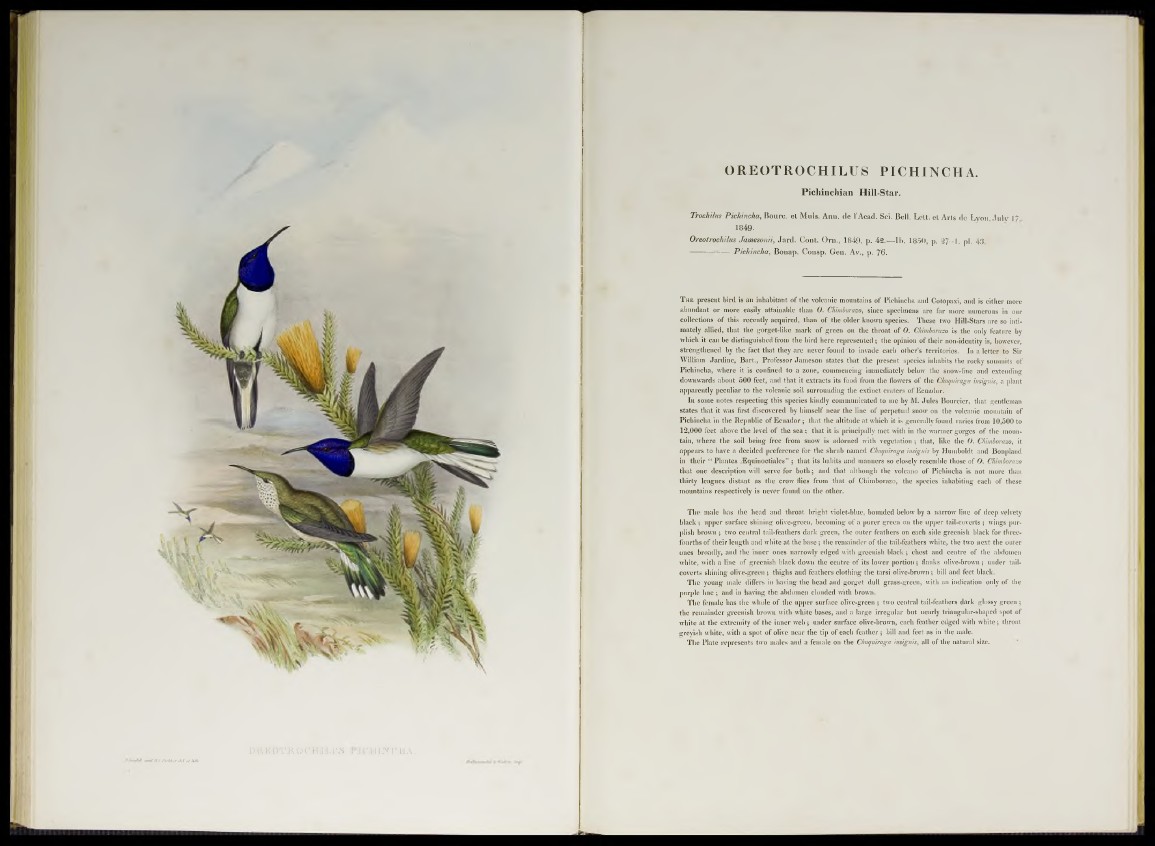
® K E© m © C H Il,C rS P 1C H W C 1 A. a u citiehtrr <M et tith.
OREOTROCHILUS PICHINCHA.
Pichinchian Hill-Star.
Trochilus Pichincha, Bourc. et Muls. Ann. de 1’Acad. Sci. Bell. Lett. et Arts de Lyon, Ju lv 17
1849.
Oreotrochilus Jamesonii, Jard. Cont. Orn., 1849, p. 42.—Il>. 1850, p. 27- 1. pl. 43.
--------------- Pichincha, Bonap. Consp. Gen. Av., p. 76.
T h e present bird is an inhabitant of the voleanic mountains of Pichincha and Cotopaxi, and is either more
abundant or more easily attainable than O. Chimborazo, since specimens are far more numerous in our
collections of this recently acquired, than of the older known species. These two Hill-Stars are so inti-
mately allied, tliat the gorget-like mark of green on the throat of O. Chimborazo is the only feature by
which it can be distinguished from the bird here represented ; the opinion of their non-identity is, however,
strengtheued by the fact that they are never found to invade eacli other’s territories. In a letter to Sir
William Jardine, Bart., Professor Jameson States that the present species inhabits the rocky summits of
Pichincha, where it is confined to a zone, commencing immediately below the snow-line and extending
downwards ahout 500 feet, and that it extracts its food from the flowers of the Chuquiraga insignis, a plant
apparently peculiar to the volcanic soil surroundiug the extinct craters of Ecuador.
In some notes respecting this species kindly communicated to'me by M. Jules Bourcier, that gentleman
states that it was first discovered by himself near the line of perpetual snow on the volcanic mountain of
Pichincha in the Republic of Ecuador; that the altitude at which it is generally found varies from 10,500 to
12,000 feet above the level of the sea: that it is principally met with in the warmer gorges of the mountain,
where the soil being free from snow is adorned with vegetation ; that, like the O. Chimborazo, it
appears to have a decided preference for the shrub named Chuquiraga insignis by Humholdt and Bonpland
in their “ Plantes ASquinoctiales” ; that its habits and manners so closely resemble those of O. Chimborazo
that one description will serve for both; and that although the volcano of Pichincha is not more than
thirty leagues distant as the crow flies from that of Chimborazo, the species inhabiting each of these
mountains respectively is never found on the other.
The male has the head and throat bright violet-blue, bounded below by a narrow line of deep velvety
black ; upper surface shining olive-green, becoming of a purer green on the upper tail-coverts ; wings pur-
plish brown ; two central tail-feathers dark green, the outer feathers on each side greenish black for three-
fourths of their length and white at the base; the remainder of the tail-feathers white, the two next the outer
ones broadly, and the inner ones narrowly edged with greenish black; chest and centre of the abdomen
white, with a line of greenish black down the centre of its lower portion; flanks olive-brown ; under tail-
coverts shining olive-green ; thighs and feathers clothing the tarsi olive-brown ; bill and feet black.
The young male differs in having the head and gorget dull grass-green, with an indication only of the
purple hue; and in having the abdomen clouded with brown.
The female has the whole of the upper surface olive-green ; two central tail-feathers dark glossy green ;
the remainder greenish brown with white bases, and a large irregular but nearly triangular-shaped spot of
white at the extremity of the inner web; under surface olive-brown, each feather edged with white; throat
greyish white, with a spot of olive near the tip of each feather; bill and feet as in the male.
The Plate represents two mal es and a female on the Chuquiraga insignis, all of the natural size.